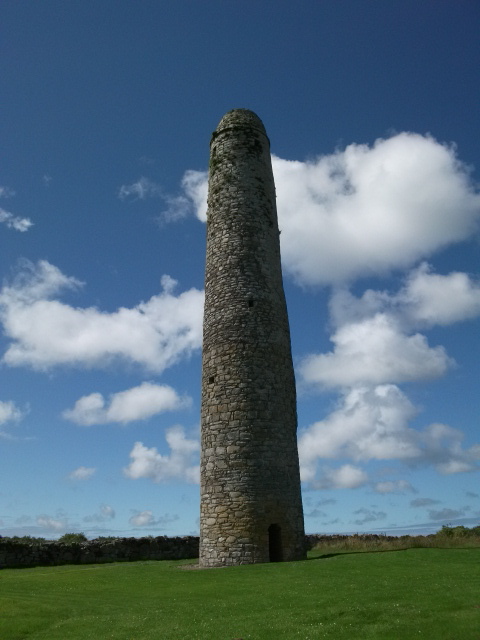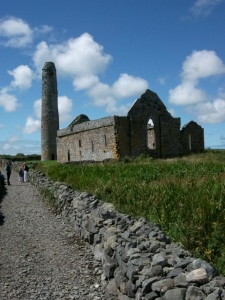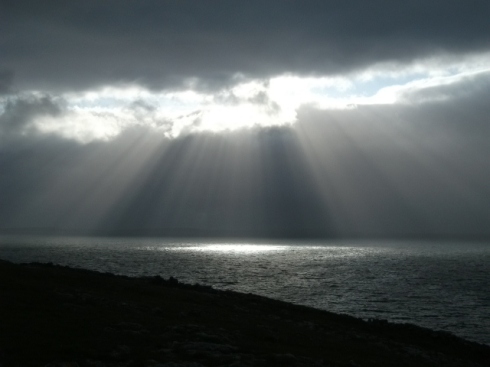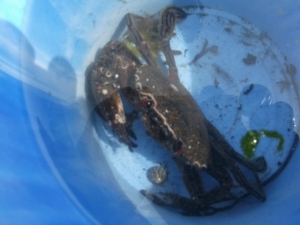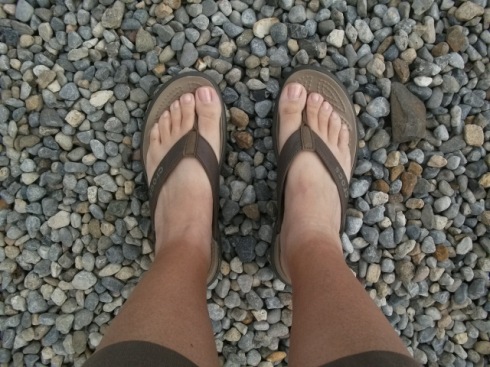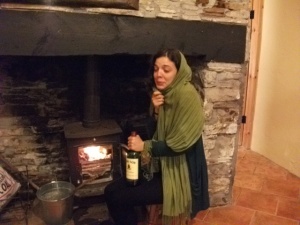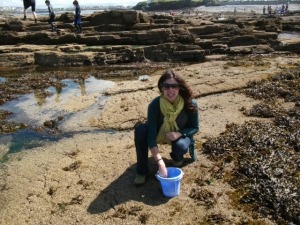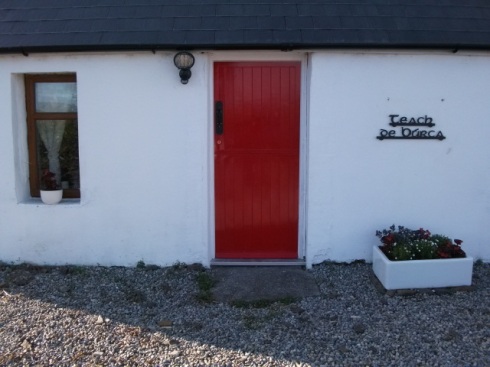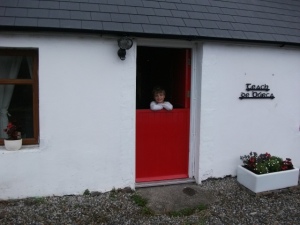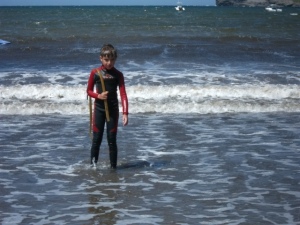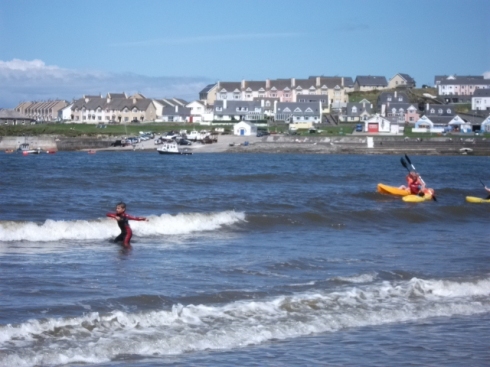You are currently browsing the tag archive for the ‘County Clare’ tag.
Standing 120 feet high, the Round Tower on Scattery Island is among the tallest in Ireland. To the monks of ancient Ireland, the height of the Round Tower advertised the importance and stature, so to speak, of the monastery it represented. Apparently the monks at St. Senan’s Monastery had a lot to be proud of!
When Kate came to Kilkee in early August to stay for a week, I made arrangements for the three of us to take a ferry from Kilrush to Scattery Island in the nearby Shannon Estuary. I figured, since Kate was moving to L.A. she would have lots of opportunities to enjoy the Pacific coastline, however while she was in Ireland, I could treat her to something she won’t find on the Pacific Coast – the ancient ruins of St. Senan’s Monastic Settlement! Scattery Island has a long history that includes Viking Raids and a community of seafaring residents who once numbered up to 141 and lived in the now deserted cottages. But it is the austere and ancient St. Senan’s Monastic Settlement that really makes this a destination worth visiting during any trip to the Loop Head area. St. Senan, a County Clare native, established his monastery on Scattery Island in the 6th century. Aside from the very impressive Round Tower, the site also includes the ruins of a stone cathedral; a small church called Teampall Senain (Church of St. Senan), also known as St. Senan’s Bed – believed to be the site of the saint’s tomb; the church of Ard na nAingeal (The Hill of the Angel); and St. Senan’s Holy Well. These ancient ruins exist within a beautiful, wild landscape of natural grasslands and wildflowers, which together, serve to transport visitors into the past.
Legend has it that upon his arrival to the island, St. Senan had a vision of the Archangel Michael, who led him to the highest hill where he could spot “The Cathach”, a sea-monster that was terrorizing the people of the area. The saint faced the monster and banished it, never to return. Once safe, St. Senan set about establishing his settlement and abbey, of which he was the first bishop. Along with banishing the sea-monster, it is believed St. Senan also banished women from setting foot on the island! This history, along with the Round Tower dominating the scene, lends a very patriarchal vibe to the site! Interestingly enough, it is said that the saint died on March 8th of 544, while paying a visit to one of the two local nunneries, which he had established on the mainland. Senan apparently liked women well enough, as long as they were not invading his island!
The day we arrived on Scattery Island was one of the mildest and sunniest of my entire stay in Kilkee. Kate, Eoin and I, along with a handful of other visitors, rode a small ferry from the dock in Kilrush to the island. During the tour we were delighted to learn that the ferry captain happened to be one of the last people born on the island, uninhabited since 1978! Except for an embarrassing disruption caused at the onset of the tour by my cell phone ringing several times with calls from Declan – until I figured out how to turn the unfamiliar phone off – our tour of this historical island was peaceful, quiet and pleasurable. We listened attentively to our guide as we walked among ancient ruins, surrounded by wildflowers and tall, natural grass blowing in a fresh breeze with the warm sun shining upon it all. We were very impressed with the natural setting where only unobtrusive stone paths have been added and briar and nettles removed from the pathways and buildings, for convenience sake. There is no visitor’s center, except for a tiny information shop housed in one of the cottages, and all the historic buildings remain respectfully in their rough condition. To Kate and me, the monastic site was perfectly presented in its natural state surrounded by an unspoiled landscape. However, a 30-something Irishwoman who came along for the tour was not as pleased and let our guide know as much in no uncertain terms. She declared that she thought it was disgraceful that the island was “let go the way it is and allowed to fill with weeds” and stated that she believed it should be “put to better use”. When the guide asked her what she would prefer they do with Scattery Island, the woman responded that it would be a great place for weddings and could be developed and rented out for functions!
Perhaps St. Senan had this woman, with her ideas for improvement, in mind when he decided to banish all women from the island so long ago!
It’s very hard to close up and say farewell to Teach deBúrca, Kilkee, Loop Head and West Clare, in general! Our last event in Kilkee tomorrow is “cake day” at Eoin’s Nevsail Watersports Camp and we’re bringing lemon cake and meringues, freshly baked by The Pantry in Kilkee. Following camp, we’ll return to the cottage to say goodbye to this place we’ve called home for the past six weeks and then it’s off to a hotel in Shannon where we will be close to the airport for our Saturday morning flight and the beginning of the long journey home.
This trip has challenged us in many ways. I had to get comfortable driving a stick shift – with my left hand and on the opposite side of the road! We had to tame a cottage that was a bit wild when we arrived. I’ve had more contact with repairmen and workmen than I ever expected and spent a good part of the beginning of our stay in combat with spiders and even a few mice. I won the battle but I am not naive enough to think I’ve won the war – especially since I must retreat until the next trip back! War or not, I am leaving a clean and cozy cottage that has benefitted a lot by a good start to the improvements we knew we needed to make.
Eoin and I have spent the last several weeks in intimate contact with the ever-changing Atlantic coastline, surrounded by breathtaking beauty and local quirkiness, housed in a peaceful, rural setting, had a braying donkey as an alarm clock, and have even become so used to the local accents that when we heard an American accent today we looked at each other and laughed at the sound! Being back in the suburbs of Chicago will be an adjustment. However, we are thankful to have had this time in West Clare and equally thankful to have people we love waiting for our return home!
Even though I’ve spent the majority of my summer in West Clare’s misty, cool weather, I have still somehow managed to get a pretty good tan. When the sun periodically breaks through the clouds it is dazzling and hot and, considering the large amount of time we’ve spent outdoors these past five weeks, I suppose it’s not surprising that we managed a bit of a suntan. Well, today I realized just how much sun I’ve been exposed to during my stay in Kilkee!
Eoin and I spent most of this afternoon observing and gathering a variety of marine life at the Pollock Holes. During the hours we were at the pools, we found the usual assortment of small, orange starfish; periwinkle; a few Sand Goby; three Sea Hares (a type of sea slug), which shot out purple dye when we disturbed them; and two little Hermit Crabs that would not stop fighting until we finally threw one back into a tide pool! A highlight of our excursion today came when a much more seasoned tide pool fisherman was kind enough to give Eoin a one-armed Velvet Swimming Crab to carry around in his bucket for a while! Mr. Seasoned-Fisherman also gave us a thrill when he called us over to see an enormous Spiny Starfish that he and his children managed to catch! Much larger than the orange, Common Starfish that we usually find in abundance, this rarer creature was about a foot in diameter and felt, well – spiny, to the touch!
All this excitement at the Pollock Holes made the time fly by and before we knew it the tide was beginning to come in and the pools were quickly disappearing around us. We gathered Eoin’s bucket and net and began to make our way back to the shore, with me looking forward to a cup of tea at Diamond Rocks Cafe. However, trouble came in the form of a jellyfish. Not the usual pale lavender Common Jellyfish we have been practically ignoring at this point, this was the larger, Compass Jellyfish with its brown stripes and frilly stingers at the bottom. Eoin managed to see it, catch it in his net and transfer it to his bucket before I was even aware that he was not following me out of the pools. After being called back to witness this treasured catch, and of course, taking the obligatory photograph, I urged him to make a run for the shore before we could no longer do it while staying dry at the same time!
Unfortunately, by this time we, along with a few other people, were standing on a rock island surrounded by water! Luckily, it wasn’t deep enough yet to force us to swim, but we did have to walk through calf-high water to the rocks that led out of the quickly disappearing pools. For Eoin in his Crocs, this was not a problem. However, I was wearing the same leather Keds and sport socks that I have lived in since we arrived in Ireland, the only pair of proper shoes with me. Sure, I could have taken off my shoes and waded through barefoot… however, after witnessing the array of sea creatures we had gathered throughout the day – nothing was going to persuade me to walk barefoot on the rocks through that water! So I risked my Keds and walked through the water in my shoes and socks – not a happy camper. After this, I skipped tea and went straight home to dry my soggy shoes and socks. Not only was I unhappy that my leather shoes were soaked through, but it disturbed me to think how it could have been much worse, with us having to swim to safety – all for the capture of one more exotic sea creature!
Now, with my soaked leather Ked’s stuffed with newspaper and drying out, I am wearing a pair of flip-flops, which I lived in back in Chicago, but haven’t touched since we arrived in Ireland with the weather and the terrain making shoes and sport socks de rigueur. So, after slipping into my unused flip-flops, I was very surprised to look down and see brown legs followed by white ankles and feet! My Kilkee tan!
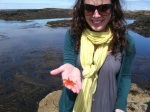 Yesterday was a sad day for Eoin and me because my daughter, Kate, headed back to Chicago after spending a week with us in Kilkee.
Yesterday was a sad day for Eoin and me because my daughter, Kate, headed back to Chicago after spending a week with us in Kilkee.
Kate’s enthusiasm and the delight she takes in her surroundings – from admiring the grandeur of the cliffs to the tiniest details, like the cup her tea is served in – makes her a kindred spirit and we have great fun together! We laughed our way through The Burren in search of The Burren Perfumery; scared ourselves investigating a holy well at the side of a dark, country road; walked along cliffs and admired the ever-changing views of the sea; took countless drives around Loop Head on bright Irish summer evenings; marvelled at dolphins and ruins; and explored the Pollock Holes – cringing at sea creatures, which Eoin handled with ease.
We oohed and ahhed over beautiful scenery, baby animals in fields, Irish pottery and handcrafts, cozy, quaint tea shops and even the perfect shade of blue paint that trimmed the windows of a stone cottage!
During our long journey through The Burren in search of the Perfumery, I joked that the three of us were “Thelma and Louise – and Bart Simpson”!
…well Louise, Bart and I had a great time exploring West Clare and sharing the cottage with you and hope you come back again and again! Slán abhaile a Kate!
With my daughter here for a week-long visit and us making the most of every moment of her stay, there has been little time for blogging from the bog! However, with both Kate and Eoin taking naps to recover from a day of dolphin watching from a boat in the Atlantic, I thought it was a great time to post a photo of our newly installed and recently painted half-door, along with our new house sign, which replaces both the old sign and the old name!
First, the door. A work of art, and an art to work! When the man who made our door installed it and then explained the intricacies of the lock and latch system, I was at first a bit overwhelmed and thought that maybe I had romanticized the old wooden half-doors, a.k.a. Dutch doors, which once graced so many old cottages in West Clare and around rural Ireland, and had bitten off more than I wanted to chew. But within a day, I was in love with this door! The latches and the locks were very easy to master and the opening and closing of this door has become a simple, yet elegant, ritual. And nothing beats having the upper half of the door open to let in the fresh Clare air and light on a mild day! A big thank you goes to Richard Beer of Irish Country Furniture for making us this beautiful, old style wooden half-door with its hidden, modern security!
Secondly, the sign and our new name. As I wrote in an earlier blog entry, “… a rose by any other name…” , when we purchased the cottage we considered keeping the name Rose Cottage, if it had any historical significance to the house. However, after a few inquiries of the locals, we found out that the name had no connection or significance to the house other than the fact that it was on the sign. Due to the lack of an actual address, the cottage needed a name, but we wanted the name to have some meaning to us. So, after finding a local forge, Paddy Murphy of Kilkee Forge, we decided to just keep it simple and name the cottage after ourselves – but to do it in Irish! Therefore, Rose Cottage is now, officially, Teach deBúrca, meaning basically “Burke House” or “Burke’s House”. It’s easy enough to say, with deBúrca pretty much sounding like it looks and “Teach” sounding like “tock or chock” – depending upon what part of the country you’re from when you say it!
Except for the major work we had done on the property to clear and level the ground and add drainage ditches, many of the details we have taken care of during this stay… such as, the door, the name, the Belfast Sink, and even finally having The Traveling Butter Dish and friends in place in the kitchen, were the little things we needed to do to put our mark on the place and make it ours. And I am happy to say that I feel very satisfied that we have accomplished this goal!
Here is a boy who, even after a winter of taking private swimming lessons to prepare for his summer in Kilkee, still didn’t like to get his face wet, let alone put his head under water!
Now he spends hours in the sea playing in the waves and riding them with his boogie board; looking for, and even picking up, marine life at the Pollock Holes; using seaweed as a toy; exploring the rocky ridge called Tucker; observing the changing tides, crashing waves, rock formations and wildlife around the cliffs; and in general enjoying a life near the sea. Now I am even hearing enthusiastic talk about his plans to surf one day… a prospect I am not as enthusiastic about!
Much of the new Eoin, I credit to his time spent this summer at Nevsail Watersports Summer Camp . Thanks to Nevsail, Eoin is now willing to spend hours in the wild and cold Atlantic Ocean, both at the camp and on his own, afterwards. In the camp, he has had the opportunity to try his hand at such watersports as kayaking, canoeing, boogie boarding, snorkeling and more – and has even spent some time building a raft! The enthusiastic young instructors at the camp have been great about encouraging this shy, hesitant boy to try activities that he would never have attempted otherwise and their kindness and sensitivity have made him feel welcome and comfortable in the camp.
Eoin’s daily explorations around the bay of Kilkee and his experience within the camp, have made him, not only more confident and comfortable with the sea, but more confident in his own skin. This makes every minute I’ve spent squeezing him into, and prying him out of, his wetsuit – and then properly cleaning it after each use – well worth the effort!
This photo greeted me on facebook this morning. I am a subscriber to a facebook page called The Loop Head Peninsula, West Clare where photographer, Carsten Krieger, posts his photos and writes snippets about the beautiful Loop Head Peninsula, which is only a short drive from our cottage in Kilkee. This particular photo, taken last Thursday, came with a declaration that “the landscape is in full bloom and flowers even grow out of solid rock.”
Beauty like this makes it no surprise that last Wednesday it was announced that Loop Head has recently been declared the winner of Ireland’s European Destination of Excellence 2010, award. This makes the Loop Head Peninsula one of 22 destinations of excellence for aquatic activities and tourism in Europe and also means that it will represent Ireland at the EU tourism day in October. With County Clare tourism suffering recently, this announcement surely comes as wonderful news and offers hope for West Clare and the Kilkee area in particular. According to The Clare Champion newspaper, “Minister for Tourism, Culture and Sport, Mary Hanafin said the award will be of huge benefit to West Clare tourism. ‘The Loop Head tourism project shows the significant achievements that can be made when the local community and tourism enterprises strive together. I have no doubt that the winning of this prestigious award will have real benefits for the local tourism sector in Clare and Ireland generally,’ she said.”
Hmmm…. with all this great publicity for Loop Head, I wonder how the parking will be in Kilkee this summer? Eóin and I may have to do a bit of walking into town… I hope the scary farm dog who lives at the end of our road accepts us as neighbors!
You can see more photos by Carsten Krieger on the facebook page – The Loop Head Peninsula, West Clare, or at his website here .
While on holiday in Ireland, between all the sightseeing of castles, caves, beaches, cliffs, dolmens and the odd ancient church and grave yard, one of my favorite things to do is to stop for tea. “Should we stop for tea?”… is a common question asked during our journeys and rarely receives a negative response. By the time the question is asked, everyone is usually feeling the need for refreshment. Although there are the usual stops for lunch or dinner, “stopping for tea” most often means a shorter, less disruptive break and, for the most part, literally means a pot of tea and perhaps a delicious dessert, which if you’re lucky, is the house specialty. These specialties may be a mixed-berry crumble, homemade scones, a simple apple tart, or a lovely slice of Banoffi… all offered accompanied by fresh, thick cream. However, you can have your tea without dessert… but never dessert without tea! Tea offers comfort from the often cold, damp weather and the slight stimulant needed to regroup and move along on the journey. As I mentioned in an earlier post, tea usually consists of a good-sized pot of fully brewed, piping hot tea, accompanied by a pitcher of milk, never cream, on the table.
A break for tea provides for replenishment of energy for the next adventure, but equally, allows travelers an opportunity to discuss the sites and occurrences experienced up to that point and to plan the next step of the journey. In addition, stopping for tea often includes a bit of conversation with the servers, proprietors and/or other customers, which enriches the travel experience, and very often can offer an opportunity to learn about a nearby site that might have been otherwise overlooked. Sometimes stopping for tea is the highlight of the day, but mostly it is just a welcome and enjoyable punctuation between the larger experiences.
Below is a photo I took during one of these “Should we stop for tea?” breaks. On our way to the Aillwee Cave – after a lengthy drive north from Kilkee, past Doolin and up along the scenic Coast Road, which included a couple of windblown walkabouts on the Burren along the way – we enjoyed a wonderful respite at Monks Pub in Ballyvaughan at around 11 a.m.. Notice the lone tea-pot on the table – my idea of “stopping for tea”. Anton and Eóin had different ideas… but we all had a great time and departed with the energy we needed to forge ahead!
I just love seeing nuns… sort of like I love touring old churches – even though I’m not particularly fond of actually attending church! There is something ‘Old World’ about the sight of these entities and something enticing about ancient tradition, either religious or not. Being around devout people and spiritual places can transport a person out of the routine of modern life.
There are a group of nuns who make part of their living in my town running espresso stands in our local library and train depot. This particular order of nuns dress from head to toe, in a habit that makes these very young women seem like apparitions from Medieval Europe. When my son was between apartments and back home with us for a month last summer, I think buying his morning coffee from the nuns at the train station was a highlight of his day because it took him outside of the morning rush hour and gave him the feeling, for a brief time each morning, that he was coming into contact with a different world. And I must admit to purchasing a few mochas at the library just for the opportunity to interact with these “strange” creatures. My curiosity and slight fascination with nuns, probably springs from the fact that I am not a Roman Catholic, therefore I have minimal experience with them or knowledge about them, and carry no nun-related baggage. In any case, this photograph of Sister Bernardine Meskell, mother abbess of the Poor Clare Monastery in Ennis, grabbed my attention while I was glancing through The Clare Champion newspaper online yesterday. Happily, the article attached to the photo gave me an excuse to include the photo here!
The Clare Champion is a County Clare newspaper, which I have linked to my desktop, so that I may browse through it now and then to see what is going on in the Rose Cottage neck of the woods. Most of the articles in the paper are not very interesting to me at the moment, since I am not attuned to the local issues. However, now and then a photo or article will entice me to read past the title, which is what happened when I beheld Sister Bernardine standing there with her umbrella and jolly smile! The purpose of the article was to announce the launching of an interesting new book entitled, Salty Faces and Ferocious Appetites – A tapestry of stories from a Seaside School, written to mark the founding, 80 years ago, of St. Joseph’s Secondary School in County Clare’s Spanish Point. The reason for the Sister’s prominence in the article is that she not only was a student of the school from 1958 to 1963, but the book’s title comes from a story she relates within the book about her years as a boarder at St. Joseph’s. The article, for the most part, quotes her story. Sister Bernardine begins,
“The sea was magic… I particularly loved the rough winter waves and those walks by the White Strand or down the Racecourse Road coming back with salty faces and ferocious appetites. A winding trail of maroon with a hint of blue regularly moved with the coast road. I still cherish the memory of those school walks. Water always held something special for me, even the rain. During the school term in Spanish Point there was plenty of both sea and rain.”
Following this enchanting beginning to Sister Bernardine’s story, the article goes on to give her recollections, described in vivid detail and with the same joyful tone as her smiling photograph portrays, about her experiences at the school, the friends she made there, the nuns who taught her and the story of what put her on the path of becoming a Poor Clare nun. Along with the reminiscences of Sister Bernardine, another 38 former pupils and teachers are featured in this book, which celebrates the many years of St. Joseph’s Secondary School. Salty Faces and Ferocious Appetites promises to not only paint a detailed picture of this one-time boarding school, but should also give interesting historical insight into a time past in County Clare, and in Irish education in general. Needless to say, this is a book I will be on a quest for, during my next trip to County Clare!
Biddy Early was known to be a bean feasa, meaning a ‘wise woman’ or ‘woman of knowledge’. Depending upon who was referring to her, she was either “the wise woman of Clare” or “the witch of Clare”. W.B. Yeats called this notorious red-head, “the wisest of wise women”. Priests spoke out against her from the pulpit, but rarely dared confront her face to face… some even quietly approached her for help. I first discovered Biddy Early a couple of years ago, when I stumbled upon a little paperback biography written by Meda Ryan called, Biddy Early: The Wise Woman of Clare, in an obscure small town book shop in either Clare or Kerry, where we stopped for lunch while en route to Dublin from the West. After purchasing the book I showed it to my husband who surprised me by saying that he had heard of her. He didn’t know all the details but he recognized her name and associated it with folklore.
Biddy Early lived her life in County Clare from 1798 until her death in 1874. She was born into a poor farming family and baptized Bridget Ellen Connors, later adopting her mother’s maiden name of ‘Early’. There are records of her existence and even her 1865 arrest for accusations of witchcraft when she was brought to court in Ennis. These charges were promptly dropped when the people, which were expected to testify against her, dropped out, most likely due to a belief that Biddy had the power to inflict curses upon anyone who crossed her. But mostly the legend of Biddy Early’s power, comes to us through stories told by those whose parents and grandparents came into contact with her. Many such stories were collected by W.B. Yeats’ contemporary, Lady Gregory and can be found in her book, Visions and Beliefs in the West of Ireland. From what I’ve read about Biddy, she was probably a healer who provided herbs and ‘potions’ meant to aid the sick. Stories tell of her gift of ‘second-sight’ that allowed her to see future events, provided information to her about things happening in the village that she would otherwise have not known and even allowed her to know in advance when a person in need was coming to see her so that she would often meet them along the road. Biddy was consulted for anything from restoring the butter production of a farm, to healing the sick. A large part of her ‘practice’ involved restoring health to ailing farm animals, a thing of vast importance to the poor farmers of her day. Many believed that she talked to the fairies and may have even gotten her powers from the fairies. A central theme of her story revolves around the use of a ‘magic’ blue bottle which she is said to have looked into in order to see her visions and find cures. One of several theories of how she acquired the bottle is that it was given to her by her son, a locally acclaimed hurler, who obtained it from the fairies as a thank-you gift when he obliged them by filling a spot in one of their hurling matches. This verse, which was composed during her lifetime, tells the story:
In ’41 when her first born son
Played a fairy game of hurley
I tell you true that the Bottle o’ Blue
Was given to Biddy Early.
Immediately after she died, the bottle disappeared. Some believed the fairies took it back. There is also a story that has the local priest pitching it into nearby Kilbarron Lake upon her death.
Biddy normally did not accept monetary fees for her services, but would accept items such as butter, bread, chickens… and most often, whiskey or poitín (Irish moonshine). The abundance of alcohol that crossed her threshold may account for the deaths of her husbands, who are all said to have died of alcohol related illnesses. This includes her last husband, a man in his 30s, whom she married when she was in her 70s, who also preceded her in death due to alcohol consumption. The consensus is that she had a total of four husbands, though some sources assert only three.
It is my guess that much of the legend of the powers of Biddy Early derive from her being a very intelligent, outspoken woman who had a good knowledge of medicinal herbs and perhaps a bit of psychic ability and sensitivity to what was going on around her. She was also a woman unafraid to go head-to-head with the local priests at a time when priests were very much deferred to. All in all, this would be a very powerful combination of characteristics in a woman of her time and that alone, fairies or no fairies, makes her an interesting character. Feakle Parish in County Clare is the place where Biddy Early spent a good portion of her life and where the ruin of her two-roomed, thatched cottage is situated. People still visit the cottage and some say there is an aura of magical energy lingering about the place. Also, I have read that Biddy still appreciates a small gift from those who cross her threshold, so people often leave tokens, though I doubt there are many bottles full of whiskey lying about! It is my intention to locate and pay a visit to the cottage during my next trip to County Clare in March, that is, if my sons are not afraid to come along!

